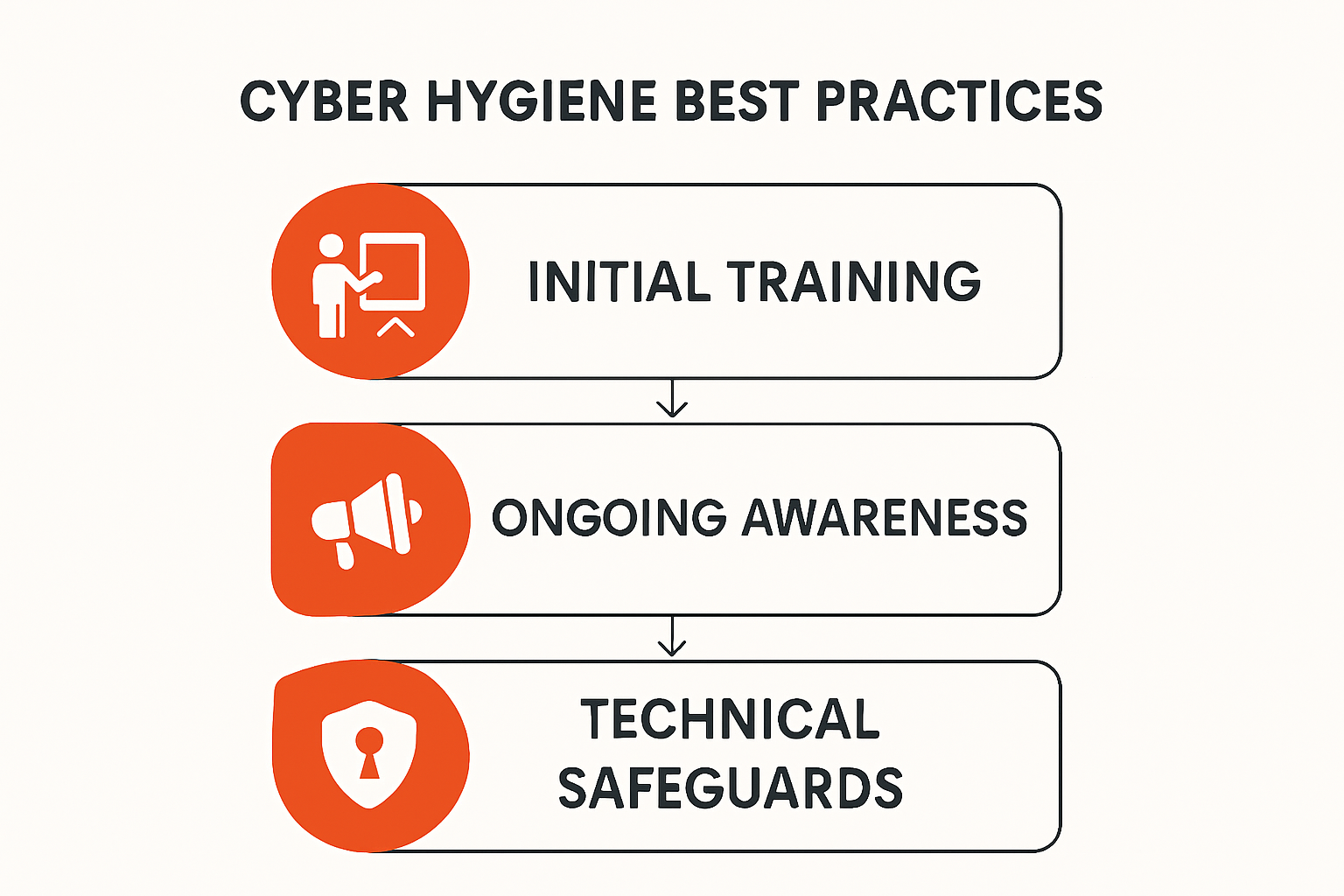Cyber Hygiene Best Practices for Business Security
Cyber attacks are getting smarter and more relentless every year. Last year, over 60 percent of small businesses in South Africa faced at least one cyber incident. Most people think only big corporates are targets, but even a tiny company with just a handful of laptops can get hit. The real shock comes when you realise that simple habits, like regular software updates or quick staff training, often make the biggest difference.
Table of Contents
- Understanding Cyber Hygiene In Modern Businesses
- Key Cyber Hygiene Best Practices For Teams
- How To Build A Company-Wide Security Culture
- Steps To Implement Cyber Hygiene For Outsourced IT
Quick Summary
| Takeaway | Explanation |
|---|---|
| Implement automated software updates. | Regularly applying updates protects systems from known vulnerabilities and enhances overall security. |
| Establish a culture of cybersecurity awareness. | Engaging employees through training transforms them into proactive protectors of digital assets, reducing organizational risks. |
| Define clear security expectations for outsourced IT. | Articulating security requirements ensures external partners meet internal safety standards, minimizing cybersecurity risks. |
| Utilize multi-factor authentication. | Adding this layer of security for logins significantly reduces the chances of unauthorized access to sensitive information. |
| Foster continuous learning about cybersecurity. | Ongoing education keeps employees updated on risks and best practices, reinforcing their role in maintaining cyber hygiene. |
Understanding Cyber Hygiene in Modern Businesses
Cyber hygiene represents the foundational strategy businesses use to protect their digital infrastructure and sensitive information from increasingly sophisticated cyber threats. It encompasses a comprehensive set of practices and protocols designed to maintain system health, secure network environments, and minimise vulnerabilities that malicious actors could potentially exploit.
The Core Elements of Cyber Hygiene
At its essence, cyber hygiene is similar to personal health maintenance but applied to technological ecosystems. Just as individuals practice regular health routines to prevent illness, organisations must consistently implement strategic measures to prevent digital infections and security breaches. Learn more about our cybersecurity essentials to understand how proactive management can transform your digital defence strategy.
The National Institute of Standards and Technology (NIST) emphasises that effective cyber hygiene involves systematic approaches to limiting employee data access. By carefully controlling information permissions, businesses can significantly reduce human error risks, which remain a primary source of potential security vulnerabilities.
Comprehensive Security Practices
Modern cyber hygiene extends beyond basic firewall implementations. According to the Federal Trade Commission (FTC), businesses must adopt multifaceted strategies including:
- Automated Software Updates: Consistently applying security patches to prevent known system vulnerabilities
- Data Encryption: Protecting sensitive information through advanced encryption techniques
- Multi-Factor Authentication: Implementing robust login verification processes
The U.S. Secret Service further recommends specific practices such as regularly changing passwords, using unique credentials for different systems, and promptly installing operating system updates. These seemingly simple actions create multiple layers of defence that can substantially reduce potential breach risks.
By understanding and implementing comprehensive cyber hygiene best practices, businesses can create resilient digital environments that protect critical assets, maintain operational integrity, and build trust with stakeholders. The investment in systematic cyber hygiene is not just a technical requirement but a fundamental business strategy in our increasingly interconnected digital world.
Key Cyber Hygiene Best Practices for Teams
Effective cyber hygiene requires a collaborative and systematic approach within organisational teams. Transforming cybersecurity from a technical challenge into a collective responsibility demands strategic implementation of practices that empower every team member to become a proactive defender of digital assets.
Establishing a Culture of Cybersecurity Awareness
Building robust cyber hygiene starts with comprehensive team education and awareness. Learn about our security awareness training to understand how organisational culture impacts digital protection. According to NIST cybersecurity guidelines, creating a security-conscious environment involves regular training sessions that transform employees from potential vulnerability points into active security practitioners.
Key educational focus areas should include:
To help readers quickly identify the most critical cyber hygiene practices mentioned for teams, the following table organises the key educational focus areas of team cybersecurity awareness.
| Cyber Hygiene Focus Area | Description |
|---|---|
| Recognising Phishing Attempts | Identifying suspicious emails and communications |
| Password Management | Creating and maintaining strong, unique passwords |
| Data Handling Protocols | Properly storing and sharing sensitive information |
- Recognising Phishing Attempts: Teaching teams to identify suspicious emails and communication
- Password Management: Developing strategies for creating and maintaining strong, unique passwords
- Data Handling Protocols: Understanding appropriate methods for storing and sharing sensitive information
Implementing Technical Safeguards and Protocols
Technical infrastructure plays a critical role in supporting team-wide cyber hygiene. Modern organisations must deploy systematic approaches that provide consistent protection across all digital touchpoints. This involves implementing multi-layered security mechanisms such as:
- Regular Software Updates: Ensuring all systems receive timely security patches
- Network Segmentation: Limiting potential breach impacts by creating controlled access zones
- Advanced Authentication Methods: Utilizing multi-factor authentication for critical system access
Teams must understand that cyber hygiene is not a one-time implementation but an ongoing process requiring continuous adaptation and vigilance. Each team member represents a potential security checkpoint, capable of detecting and preventing potential cyber threats before they escalate.

By fostering a collaborative approach to cybersecurity, organisations can create resilient digital environments where technical safeguards and human awareness work synergistically to protect critical business assets. The most effective cyber hygiene strategies recognise that technology and human behaviour are interconnected components of a comprehensive security ecosystem.
How to Build a Company-Wide Security Culture
Creating a robust security culture requires more than implementing technical solutions. It demands a holistic approach that integrates cybersecurity awareness into every organisational process, transforming security from a technical requirement to a shared organisational value and responsibility.
Leadership and Strategic Commitment
Building a comprehensive security culture starts at the top. Explore our comprehensive security strategy guide to understand how leadership shapes organisational security perspectives. According to research from Gartner, executive leadership must visibly demonstrate commitment to cybersecurity, making it a strategic priority that goes beyond technical departments.
Effective leadership in security culture involves:
- Consistent Communication: Regularly discussing cybersecurity importance
- Resource Allocation: Investing in training and technological solutions
- Leading by Example: Demonstrating personal adherence to security protocols
Comprehensive Training and Engagement Strategies
Security awareness cannot be a one-time event but must become an ongoing, interactive process. Cybersecurity experts recommend developing multi-dimensional training programs that engage employees through various learning methods:
- Interactive Workshops: Hands-on sessions simulating real-world cyber scenarios
- Gamification: Creating competitive learning experiences that make security education engaging
- Continuous Learning Modules: Regular short training updates to keep security knowledge current
Organisations must move beyond traditional compliance-based approaches and create environments where employees feel empowered and motivated to participate actively in maintaining digital security. This involves transforming security from a perceived burden to a collective responsibility that everyone understands and values.
By integrating security awareness into daily workflows, recognising and rewarding proactive security behaviours, and maintaining transparent communication about potential risks, businesses can develop a security culture that becomes an intrinsic part of their organisational DNA. The most successful security cultures are those where every team member understands that cybersecurity is not just an IT department’s job, but a shared commitment to protecting the organisation’s most valuable digital assets.

Steps to Implement Cyber Hygiene for Outsourced IT
Outsourcing IT services introduces unique cybersecurity challenges that require strategic and systematic approaches to maintain robust digital protection. Businesses must develop comprehensive frameworks that ensure external service providers align with internal security standards and maintain rigorous cyber hygiene practices.
Establishing Clear Security Expectations
Learn about selecting the right IT service model to understand how contractual frameworks impact cybersecurity. When engaging outsourced IT partners, organisations must define explicit security requirements that go beyond standard service level agreements.
According to Gartner’s cybersecurity research, comprehensive vendor security assessments should include:
- Detailed Security Compliance Documentation: Requiring comprehensive proof of existing security protocols
- Regular Security Audits: Mandating periodic independent security assessments
- Incident Response Capabilities: Defining clear protocols for potential security breaches
Technical Integration and Monitoring Strategies
Successful cyber hygiene with outsourced IT requires sophisticated technical integration methods. Cybersecurity experts recommend implementing multilayered verification mechanisms that provide continuous visibility into external service provider activities:
Below is a summary table outlining the recommended safeguards and monitoring strategies specifically for managing cyber hygiene when working with outsourced IT partners, as described in the article.
| Safeguard or Strategy | Purpose |
|---|---|
| Real-Time Access Monitoring | Tracking and logging all system interactions |
| Restricted Access Controls | Implementing granular permission management |
| Network Segmentation | Creating isolated environments for external provider access |
- Real-Time Access Monitoring: Tracking and logging all system interactions
- Restricted Access Controls: Implementing granular permission management
- Network Segmentation: Creating isolated environments for external provider access
Businesses must recognize that outsourcing does not diminish cybersecurity responsibility. Instead, it requires more sophisticated oversight and proactive management. Every external touchpoint represents a potential vulnerability that demands careful, strategic management.
By developing robust frameworks that blend contractual clarity, technical safeguards, and continuous monitoring, organisations can effectively manage cyber hygiene risks associated with outsourced IT services. The most successful approaches treat external providers as extensions of internal security ecosystems, ensuring consistent protection across all digital interactions.
Frequently Asked Questions
What are the best practices for maintaining cyber hygiene in a business?
Implementing automated software updates, establishing a culture of cybersecurity awareness, and utilizing multi-factor authentication are essential best practices for maintaining cyber hygiene in a business.
How can I train my employees on cybersecurity awareness?
Conduct regular training sessions that include workshops on recognizing phishing attempts, password management, and proper data handling protocols to foster a culture of cybersecurity awareness among employees.
What role does leadership play in building a security culture?
Leadership is crucial for establishing a security culture by demonstrating commitment through consistent communication about cybersecurity, allocating resources for training, and setting an example by following security protocols personally.
How can I ensure the cybersecurity practices of outsourced IT services?
Establish clear security expectations with outsourced IT partners by requiring detailed security compliance documentation and implementing regular audits to ensure they meet internal security standards.
Ready to Make Cyber Hygiene the Foundation of Your Business Security?
You have learned how cyber threats are evolving fast and that basic habits, like regular updates and employee awareness, are essential for digital safety. But when you run a professional services firm or a growing operation, the weight of protecting sensitive data and ensuring compliance can feel overwhelming. Many companies lose sleep over gaps in their cyber hygiene. Weak software updates, inconsistent staff training, or vague outsourced IT arrangements put both your reputation and your clients at risk.
If you want total peace of mind, you need a managed IT partner that turns these cybersecurity best practices into your daily reality. At Techtron, we do more than just patch systems. We deliver proactive support, expert training, and advanced monitoring tailored for firms like yours. Let us handle your digital defences so you can focus on running your business without worry. Take your next step towards a safer and stronger IT environment by visiting Techtron’s main site today and discover how our solutions keep your business one step ahead. Do not wait until a cyber incident hits before you act. Get in touch now to secure your future.